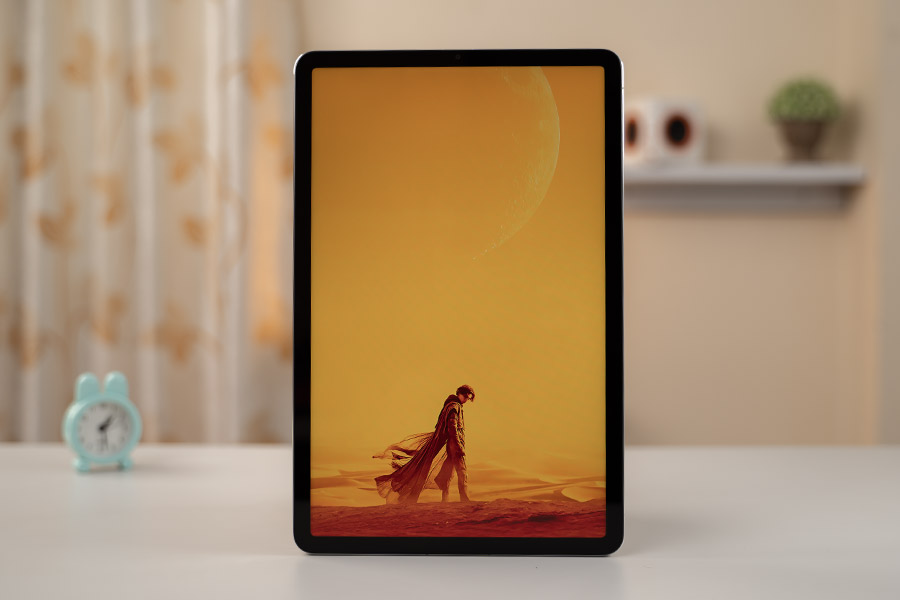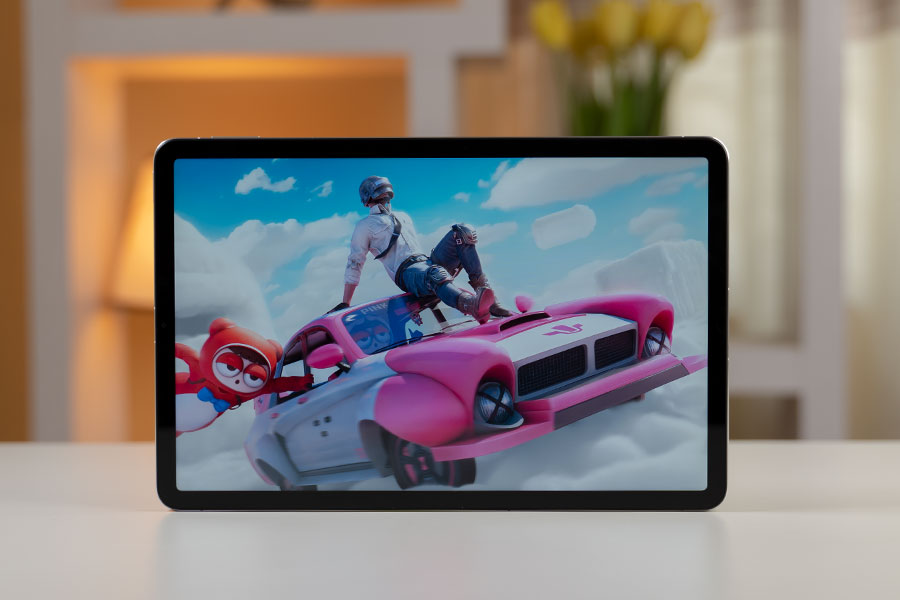When rumors about Xiaomi re-entering the tablet industry started circulating, people had big expectations from what was yet to come. After initially launching the Mi Pad 5 series in China, the entry model in this lineup—called the Xiaomi Pad 5—has made its way to the global market including Europe, Malaysia, and Nepal. And this is my early impressions of the Xiaomi Pad 5.
For the most part, this mid-range tablet seems to have met the public expectation just fine. I mean, the sub-flagship—or heck, even Android tablets in general—are hanging by a thread as Apple continues to blow the competition out of the water with its every new iPad iteration. But with Xiaomi back in the game, things should get even more competitive.
Xiaomi Pad 5 Specifications:
- Body: 166.25 x 254.69 x 6.85mm, 511 gm, Glass-plastic hybrid build
- Display: 11-inches IPS LCD panel, 120Hz refresh rate, 240Hz touch sampling rate, Dolby Vision HDR, HDR10+, DCI-P3, 500 nits brightness
- Resolution: WQHD+ (2560 x 1600 pixels), 16:10 aspect ratio, 275 PPI
- Chipset: Qualcomm Snapdragon 860 (7nm Mobile Platform)
- Memory: 6GB LPDDR4X RAM, 128/256GB UFS 3.1 storage (fixed)
- Software & UI: Android 11 with MIUI for Pad on top
- Rear Camera: Single (13MP f/2.2 sensor)
- Front Camera: Single (8MP f/2.05 sensor)
- Audio: Quad-speaker setup, Dolby Atmos, Hi-Res Audio
- Security: No fingerprint sensor, Face unlock
- Sensors: Accelerometer, Light, Magnetometer, Gyroscope, Color Temperature
- Connectivity: WiFi 802.11 a/b/g/n/ac (Dual-band), Bluetooth 5.0, USB Type-C
- Battery: 8720mAh with 33W fast charging (22.5W adapter provided)
- Accessories: Keyboard, Xiaomi Smart Pen (not available in Nepal)
- Color Options: Pearl White, Cosmic Gray
- Price in Nepal: Rs. 44,999 (6/128GB) | Rs. 49,999 (6/256GB)
- What's inside the box: Tablet, Power adapter, USB-A to USB-C cable, quick start guide, warranty card
Xiaomi Pad 5 Impressions
Kicking off the initial impressions with the design, I’m really digging this Pearl White finish of the Xiaomi Pad 5. The sunny reflections off of this dual-layer camera island look pretty mesmerizing, although I’m not that big a fan of how easily this plastic back catches fingerprints and smudges.

And getting them off requires quite a bit of effort too. Needless to say, you’ll want to wrap it up in a protective case/skin. The flat frames are aluminum-made, which is a nice touch. Here, the right side hosts the volume rockers, two microphones, and a magnetic strip for the Xiaomi Smart Pen.
On the contrary, there’s the three-pin POGO connector on the left to attach the keyboard accessory. Over on the top, you have two speaker grilles, one microphone, and a power button.
Finally, completing Xiaomi Pad 5’s quad-speaker setup are two more speaker vents on the bottom where you’ll also find an additional mic and a USB-C port. If you haven’t figured it out already, there’s no SIM tray on this tablet, meaning it’s void of LTE connectivity.
Moreover, the power button doesn’t integrate a fingerprint scanner, whereas a 3.5mm headphone jack is missing as well. At 511 grams, the Pad 5 has a noticeable heft to it but I find its lower half to be considerably heavier than the rest of the body. Over time, I’m sure I’ll get used to it—so it’s not a big deal.
How's the display?
Getting to the display, the Xiaomi Pad 5 brings an 11” IPS panel with a 120Hz refresh rate and 2K resolution.
And right away, I was a bit let down by the thickness of these bezels since all the official promotional materials render relatively thinner bezels. I mean, it’s certainly not a deal-breaker and the larger area of the bezels does help prevent accidental touches—but maybe slightly narrower bezels would’ve been just the icing on the cake.
Nevertheless, as hinted by the packaging itself, this screen is Dolby Vision HDR certified for those supreme contrast levels on compatible contents. But because it isn’t backed by an OLED panel, you’re not going to get that “signature” Dolby Vision experience with perfect black levels.

In contrast, the Lenovo Xiaoxin Pad Pro—which has pretty comparable specs to this one—boasts an OLED display but a 90Hz refresh rate.
So yeah, the Xiaomi Pad 5 doesn’t have the best-in-class display but it comes pretty damn close.
The colors look quite vibrant for an LCD screen, and it’s definitely a big step up from the IPS panels that we have seen on Xiaomi’s mid-range phones. Plus, I have no complaint regarding the content sharpness either.
Color temperature sensor
On top of this, it is also backed by a dedicated color temperature sensor which automatically adjusts the display’s colors based on the ambient lighting. Sort of like Apple’s True Tone technology on iPads, iPhones, and MacBooks.
However—in my brief experience with the tablet—it seems that all it does is introduce a warmer hue no matter the surrounding lighting condition. Maybe Xiaomi still has some optimizations left to do and it’ll get better with future updates.
More on the display, I feel like this could be an unpopular opinion but I really enjoyed the extra punchy colors of the Saturated color profile. For a large tablet geared towards content consumption, the added vibrancy is a treat to my eyes. Further complemented by a smooth 120Hz refresh rate, Xiaomi Pad 5’s display gives you even more reason to love it.
Review Images
1/2
Top
I’m yet to notice any weird micro stutters so far but I’ll reserve my final verdict for the full review. To appeal to the content consumption crowd, there’s a quad-speaker setup with Dolby Atmos audio. And my initial impression remains that these speakers sound really good—but only at high volume.
Quad-speakers with Dolby Atmos
The stereo separation and the soundstage are impressive and there’s even a hint of bass to enjoy. In the default “Dynamic” preset, it definitely feels like Xiaomi has tuned the speakers with a bright sound signature since the treble and mid-frequencies sound much more pronounced—especially the latter. This is quite apparent when listening to something like “Space Cowboy” by Saib.
But when keeping the volume down, things sound a little flat—with the aforementioned bass cameo signing off completely. Admittedly, this shift is still ideal for watching something with less dynamic audio like sitcoms/movies, but not songs as much. To test it out more, I’ll be playing with the equalizer settings to see if things change at all, so watch out for that review.
Mighty powerful
On the performance side of things, the Xiaomi Pad 5 is powered by Qualcomm Snapdragon 860 which is basically a repackaged 855+.
We’ve seen this chip in action on the POCO X3 Pro before—and sad to say—it failed to leave a good impression on us. Simply put, the 860 heat up to a terrible degree (pun intended) under heavy load. Then again, thanks to its larger chassis, this tablet should be able to keep the temperature in check.
In terms of memory, there’s 6GB of LPDDR4X RAM and either 128 or 256GB of UFS 3.1 storage. I’m so glad that Xiaomi didn’t go with a 4GB RAM variant like Samsung did with the Galaxy Tab S7 FE.
I mean, for a device with immense multitasking possibilities, pairing it with a mere 4GB of RAM would be crippling. Likewise, we’ve faced memory management issues with budget Xiaomi phones featuring 4GB or less volatile memory—so there’s that as well.

And running the whole show is MIUI for Pad which is pretty much MIUI 12.5 with a tablet-like layout. That’s it. If you were hoping for any tablet-specific feature, you’ll be setting yourself for a disappointment.
MIUI for Pad has a loooooong way to go
The Xiaomi Pad 5 can launch two apps simultaneously or open one in a floating window, but there’s no option to pin app combos, an edge panel to simplify multitasking, and so on. Then there’s the usual MIUI complaint about its lack of optimization.
For instance, this time—for seemingly no logical reason—the Control Center lacks a Settings shortcut. I know it sounds like such a minor thing but having to jump to the homescreen to access the Settings menu every time is such a drag. I’m hopeful things will change for the better with the Android 12L-based update—although I’m keeping my expectations low.
All in all, Xiaomi has a lot of work cut out for itself if it hopes to compete against the likes of Samsung Galaxy Tab or even Apple’s iPads someday. By the way, this is a retail unit so I can’t blame any of it on unpolished pre-production software either.
How about the cameras?
At the back, the Xiaomi Pad 5 has a Mi 11-inspired camera module that houses a 13MP sensor alongside the LED flash. Similarly, the 8MP front camera is vertically placed inside the top bezel. It would’ve made more sense if the selfie camera was located in a landscape layout in this climate dominated by online classes and virtual meetings though.
Review Images
1/3
From the few images I’ve managed to capture so far, this camera setup looks to be just about average. The 13MP lens captures decent shots for a tablet but the photos aren’t that detailed and have a pretty terrible dynamic range.
Review Images
1/2
On the other hand, the front-facing camera delivers quite oversharpened images whereas the dynamic range is once again ghastly. Still and all, this is more than well-equipped to get you through your video calling needs.
Moving on, fueling the Xiaomi Pad 5 is a sizable 8720mAh battery. I obviously haven’t gotten to test out its endurance but you can expect over 10 hours of gaming or 16 hours of video playback on a single charge says Xiaomi. Like I mentioned earlier, there’s a 22.5W power adapter inside the box while this tablet supports up to 33W fast charging.
Xiaomi Pad 5 Impressions: Final Words
Summing up my early impressions of this device, it goes without saying that the Xiaomi Pad 5 is an excellent value-for-money Android tablet. Even though it performs strongly as a home entertainment unit, there’s still a couple of critical compromises keeping it from being an easy recommendation to everyone.
First off, MIUI for Pad needs a lot more optimization—a lot more. Plus, there’s no cellular variant available of this tablet, while the Xiaomi Smart Pen is also ridiculously expensive at EUR 99.

To say something about myself, I have been writing tech and gadgets from 2021. Although coming from a non technical studies background, I'm someone who is always fascinated by the latest gadget and tech innovations, circling around. Besides writing, you'll find me listening music and aligning the stars through astrology and sometimes even, tarot cards! 😉🧿
Comments
No comments yet. Add a comment to start a discussion



















